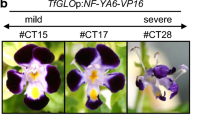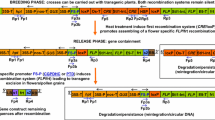Abstract
Pigmentation in flowers of Japanese morning glory is intense in the epidermal layer, lighter in the subepidermis, and much lighter in the internal tissues; by contrast coloration in stems occurs only in the sub-epidermal layer. The a-3 f mutant of Japanese morning glory bears white flowers with normal-colored flecks and sectors, and its variegation also occurs in leaves and stems. The mutable line can produce chimeric flowers pigmented uniformly in the sub-epidermal tissue and variegated in the epidermal layer, and stems of these flowers are also pigmented. Since they give selfed progeny that segregate to give a ratio of three germinal revertants bearing fully colored flowers to one flecked mutant, it has been [OR Imai (1934) has] postulated that somatic mutations in the sub-epidermal layer can be transmitted to the next generation and that the germ cells in the reproductive organs must form from the cells of the sub-epidermal layer. Recently, we found that the 6.4-kb En/Spm-related transposable element, Tpn1, resides within the DFR-B gene for anthocyanin biosynthesis in the mutable a-3 f line. To test whether somatic mutations caused by Tpn1 excision from the DFR-B gene in the subepidermis of periclinally chimeric flowers are transmissible to their progeny, we have examined the structure of the DFR-B region in the germinal revertants derived from the chimeric flowers and compared the sequences generated by the somatic excision of Tpn1 in periclinally chimeric flowers with those in their germinal revertants. Our results confirm that somatic mutations caused by Tpn1 excision from the DFR-B gene in the sub-epidermal tissue of chimeric flowers can be transmitted to their progeny, which results in the generation of germinal revertants.
Similar content being viewed by others
References
Beld M, Martin C, Huits H, Stuitje AR, Gerats AGM (1989) Flavonoid synthesis in Petunia hybrida: partial characterization of dihydroflavonol-4-reductase genes. Plant Mol Biol 13:491–502
Brugliera F, Holton TA, Stevenson TW, Farcy E, Lu C-Y, Cornish EC (1994) Isolation and characterization of a cDNA clone corresponding to the Rt locus of Petunia hybrida. Plant J 5:81–92
Carpenter R, Coen ES (1995) Transposon-induced chimeras show that floricaula, a meristem identity gene, acts non-autonomously between cell layers. Development 121:19–26
Coen ES, Robbins TP, Almeida J, Hudson A, Carpenter R (1989) Consequences and mechanisms of transposition in Antirrhinum majus. In: Berg DE, Howe MM (eds) Mobile DNA. American Society for Microbiology, Washington, D.C., pp 413–436
Fedoroff NV (1989) Maize transposable elements. In: Berg DE, Howe MM (eds) Mobile DNA. American Society for Microbiology, Washington, D.C., pp 375–411
Forkmann G (1993) Genetics of flavonoids. In: Harborne JB (ed) The flavonoids: advances in research since 1986. Chapman and Hall, London, pp 537–564
Gierl A, Saedler H (1992) Plant-transposable elements and gene tagging. Plant Mol Biol 19:39–49
Goodrich J, Carpenter R, Coen ES (1992) A common gene regulates pigmentation pattern in diverse plant species. Cell 68:955–964
Hagiwara T (1956) Genes and chromosome maps in the Japanese morning glory. Bull Res Coll Agric Vet Sci Nihon Univ 5:34–56
Hoshino A, Inagaki Y, Iida S (1995) Structural analysis of Tpn1, a transposable element isolated from Japanese morning glory bearing variegated flowers. Mol Gen Genet 247:114–117
Huala E, Sussex IM (1993) Determination and cell interactions in reproductive meristems. Plant Cell 5:1157–1165
Imai Y (1931) Analysis of flower colour in Pharbitis nil. J Genet 24:203–224
Imai Y (1934) On the mutable genes of Pharbitis, with special reference to their bearing on the mechanism of bud-variation. J Coll Agric Imp Univ Tokyo 12:479–523
Imai Y (1935) The mechanism of bud variation. Am Nat 69:587–595
Imai Y (1938) The genes of the Japanese morning glory. Jpn J Genet 14:24–33
Inagaki Y, Hisatomi Y, Suzuki T, Kasahara K, Iida S (1994) Isolation of a Suppressor-mutator/Enhancer-like. transposable element, Tpn1, from Japanese morning glory bearing variegated flowers. Plant Cell 6:375–383
Kihara H (1934) (in Japanese). Vererbungsstudien über eine “flecked”-Sippe bei Pharbitis nil. I. Bot Zool (Shokubutsu oyobi Doubutsu) 2:1801–1814
Kroon J, Souer E, de Graaff A, Xue Y, Mol J, Koes R (1994) Cloning and structural analysis of the anthocyanin pigmentation locus Rt of Petunia hybrida: characterization of insertion sequences in two mutant alleles. Plant J 5:69–80
Nevers P, Shepherd NS, Saedler H (1986) Plant transposable elements. Adv Bot Res 12:103–203
Sambrook J, Fritsch EF, Maniatis T (1989) Molecular cloning: a laboratory manual, 2nd edn. Cold Spring Harbor Laboratory, Cold Spring Harbor, New York
Tilney-Bassett RAE (1986) Plant chimeras. Edward Arnold, London
Author information
Authors and Affiliations
Additional information
Communicated by I. Potrykus
Rights and permissions
About this article
Cite this article
Inagaki, Y., Hisatomi, Y. & Iida, S. Somatic mutations caused by excision of the transposable element, Tpn1, from the DFR gene for pigmentation in sub-epidermal layer of periclinally chimeric flowers of Japanese morning glory and their germinal transmission to their progeny. Theoret. Appl. Genetics 92, 499–504 (1996). https://doi.org/10.1007/BF00224550
Received:
Accepted:
Issue Date:
DOI: https://doi.org/10.1007/BF00224550




